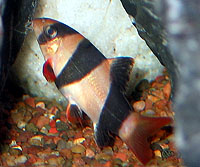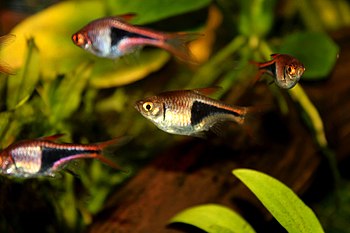 |
| Harlequin rasbora, Trigonostigma heteromorpha (Photo credit: Wikipedia) |
The Cyprinidae family of fish have many fish that are great for aquariums. Some of them are a little easier to maintain than others, but no less fun. This family consists of carps and minnows, which are tiny fish.
The Harlequin Raspbora fish are known for the colorful bodies and high spirit in the tank. One of their main characteristics is the dark triangular shape on the tail end of the fish. It starts in the middle of the body and continues to the end of the fin. These fish, which are part of the Rasbora Heteromorpha family, are popular among freshwater aquariums. They come from Thailand, Eastern Sumatra and the Malay Peninsula and can reach about 1 3/4 length.
Aquarium owners love harlequin fish because they do well in communal tanks. They aren't going to fight with the other fish are get territorial. They enjoy a little bit of everything when it comes to hanging out in the tank. While they they enjoy the top of the tank, they also like little hiding spots to hide in vegetation, but give them plenty of open water to swim in.
Harlequin are friendly fish, but do enjoy their own kind. Try to keep them in a small school, at three to six of them should be in your tank. Not only is this for the fish's sakes, but a group of them are a great sight in your tank as the lights glisten off the fish's shiny, colorful body.
Water conditions: These freshwater fish are easy to care for as long as you do the right thing. The water for the harlequin fish should be kept around 76 degrees Farhenheit. They enjoy soft water and peaty water. Use a peat bag in your filter for them. The water should also be slightly acidic. Keep the pH in the 6.0 to 6.5 range.
Aquarium conditions: Consider live plants for the harlequin's aquarium. Find plants that are native to the harlequins natural habitat. These fish also prefer dim lighting. It's best to find plants and other fish that will enjoy the same environment.
Feeding: The harlequin is perfect when it comes to food. They aren't demanding and will eat many things. Try flakes, dried, frozen and live foods. By giving them a good diet range, you can make sure they won't have any digestive problems.
 |
| A clown loach (Photo credit: Wikipedia) |
Loaches are interesting freshwater fish. These are the scavengers in your freshwater aquarium. They tend to stay around the bottom of the tank feeding on anything they could find. Many live in low quality water such as murky rivers and have adapted by coming up to the surface and breathing in atmospheric oxygen. One of the more popular loaches for aquariums is the clown loach. They make interesting fish to keep because they also eat the algae in the tank, making cleaning a little easier.
Water conditions: The temperature should be pretty warm. They like it to be around 84 degrees Fahrenheit with a pH around 6.5. Loaches are sensitive to water quality. Keep the water clean with a good filter. Also, the clown loaches prefers a higher moving current just like their freshwater environment.
Aquarium conditions: Line the bottom of the tank with sand or gravel that the clown can dig into. You should have live plants in the tank, but this will change based on the clown loach. A young loach can keep with most plant species, but adult loaches prefer plants such as the java fern and anubias. The clown loaches live to hid, so the more places they can squeeze into, the happier they will be. Don't worry if the loach digs himself into a hole. He's just relaxing.
There are so many different freshwater fish to choose for your aquarium, it's going to be hard to pick just one. Find the ones you are going to enjoy most and take great care of them.
Abhishek is an avid Fish Lover and he has got some great Aquarium Care Secrets up his sleeves! D Article Source: EzineArticles |


